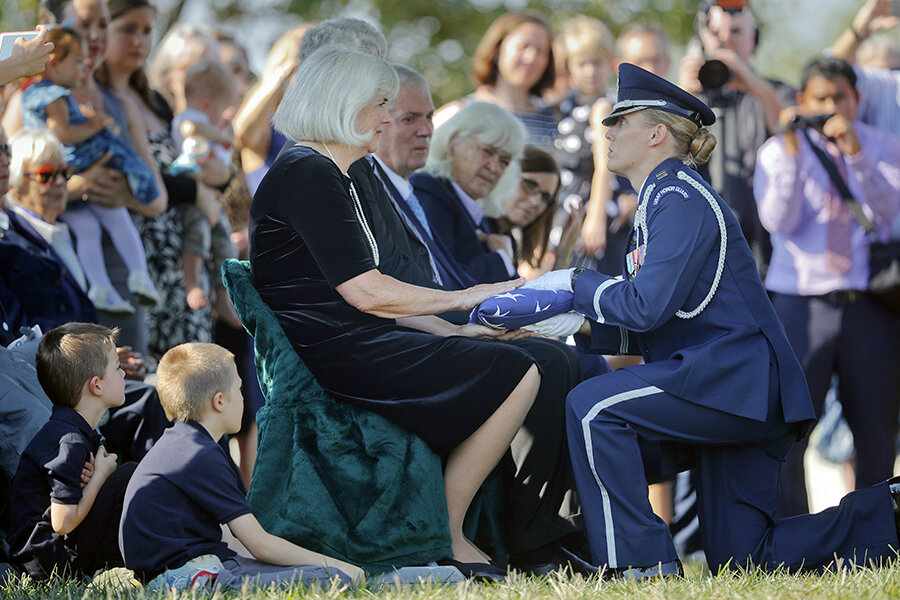Memorial, and a milestone, for pioneering female World War II pilot
Loading...
| Arlington, Va.
Against her mother’s wishes, Elaine Harmon signed up to be a Women's Airforce Service Pilot, the World War II program launched to bring much-needed women flyers into the force.
The wash-out rate was high: Of the more than 25,000 women who applied for the program, only 1,084 women ultimately earned their wings, including Ms. Harmon. They served their country in wartime: 38 WASPs lost their lives during stateside flying duties.
And yet, their service did not allow them to be buried in Arlington National Cemetery – until this week, when Harmon was laid to rest. It was the first time a World War II WASP earned that honor on her own merit. (Some 20 other WASPs are buried at Arlington because they were wives of veterans.)
The ceremony marked a final breakthrough for a group of women whose careers crashed through gender barriers and paved the way for other women in the military. It took an act of Congress and more than a year of perseverance by relatives and others after Harmon’s passing to get the right to the official burial. Hundreds came from as far away as California and Florida to honor the legacy.
“It’s inspiring to see that the WASPs have finally gotten the recognition they deserve,” said one female Air Force captain and C-17 pilot, who asked not to be named because she was not sure whether she was authorized to speak with the media.
Particularly in a male-dominated field, “support is always welcome,” added another female captain and KC-10 pilot.
A flag of tribute
Harmon was laid to rest with a flag that female fighter pilots had flown in their planes as a tribute to Harmon and her fellow WASPs.
After taking the flag for a flight in her fighter jet, an F-16 pilot wrote in a log, thanking Harmon for paving the way for her career. “I’m humbled every time I think of the legacy of the WASPs.”
Another wrote that she “drew on the strength of those who went before me,” to fly her fighter jet, which she brought up to supersonic speed when she was flying with Harmon’s flag “just for fun.”
An F-15 instructor took the flag up during a mock dogfight, thanking Harmon and her fellow WASPs for the opportunity “not only to fly, but to be considered an equal in the sky.” Now her students, “stop me in the halls to ask me how I fight, how I fly,” she wrote.
The ceremony caused WASP Shirley Kruse, who traveled to the ceremony from Pompano Beach, Fla., to reconsider whether she wanted to be buried at Arlington. “Maybe they fought so hard for this,” Ms. Kruse says, adding that she may just opt for an Arlington burial after all.
That fight involved legislation that was passed unanimously earlier this year. US Rep. Martha McSally (R) of Arizona, a former military fighter pilot herself, recalls learning that WASPs were not permitted to be buried at Arlington. Until 1977, they were not even recognized as veterans.
“I thought, “Are you kidding me?’ ” Representative McSally recalls. “These women were getting one last slap in the face.”
Fight for recognition
She contacted Pentagon leadership. “They literally said, ‘We think it’s going to take an act of Congress’ ” to change the laws of burial at Arlington. McSally realized it would have to happen quickly, with 100 WASPS still alive.
This week, Harmon received a flyover of the World War II Warbirds at her service, as well as taps and a 21-gun salute.
Her grandchildren remembered a beloved grandmother who was an adventurous traveler, visiting all seven continents, including a trip to New Zealand where she bungee-jumped at the age of 83.
Granddaughter Tiffany Miller recalled her knack for ruining the food she cooked, and her penchant for removing radios from the cars she bought, so everyone had to sing songs.
Ms. Harmon’s husband, Ernest, was a veteran who died in a plane crash was buried at Arlington, their daughter Terry Harmon pointed out during the family memorial service Wednesday. “She could have been buried with her husband, but it was important to her to carry on the legacy of the WASPs,” Ms. Harmon said.
Granddaughter Erin Miller recalled how proud she felt when she went out to lunch with her grandmother, and veterans recognized her, and came up to thank her. Then Harmon passed away in April 2015 and Army officials told Miller that her grandmother was not eligible for burial at Arlington. While her family fought to change the legislation, her ashes sat in Ms. Miller’s closet.
“It was the first time I thought her service was viewed as ‘less than,’ ” she said, which is why in the campaign to change the law it meant so much to see “hundreds of thousands of people come forward to say, ‘No, it’s not.’ ”








